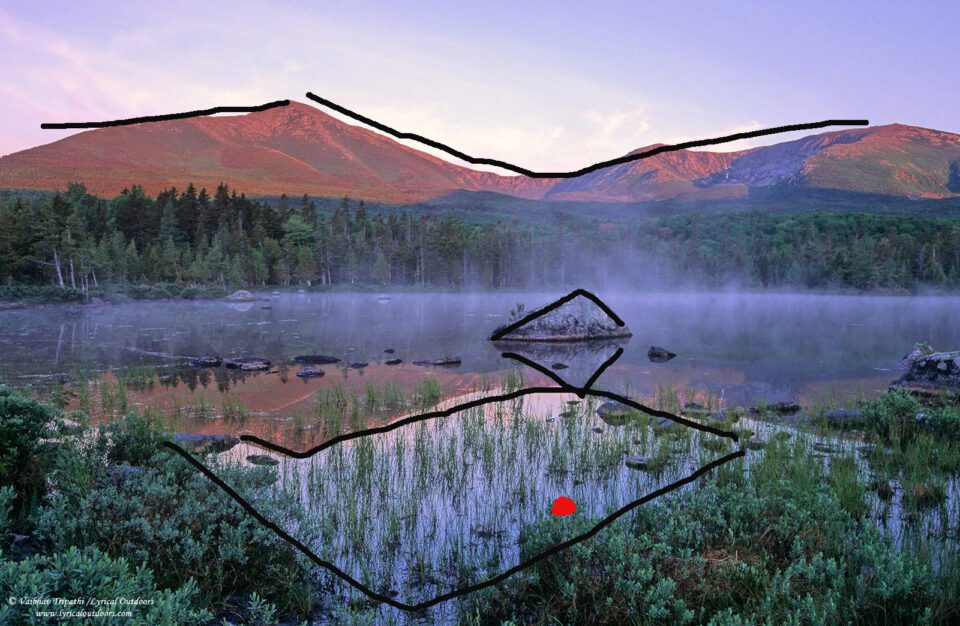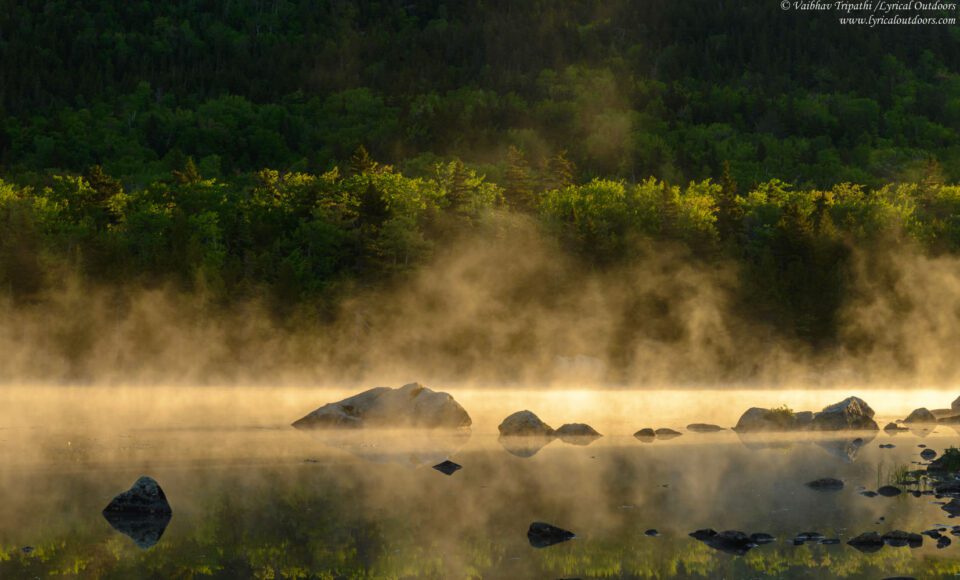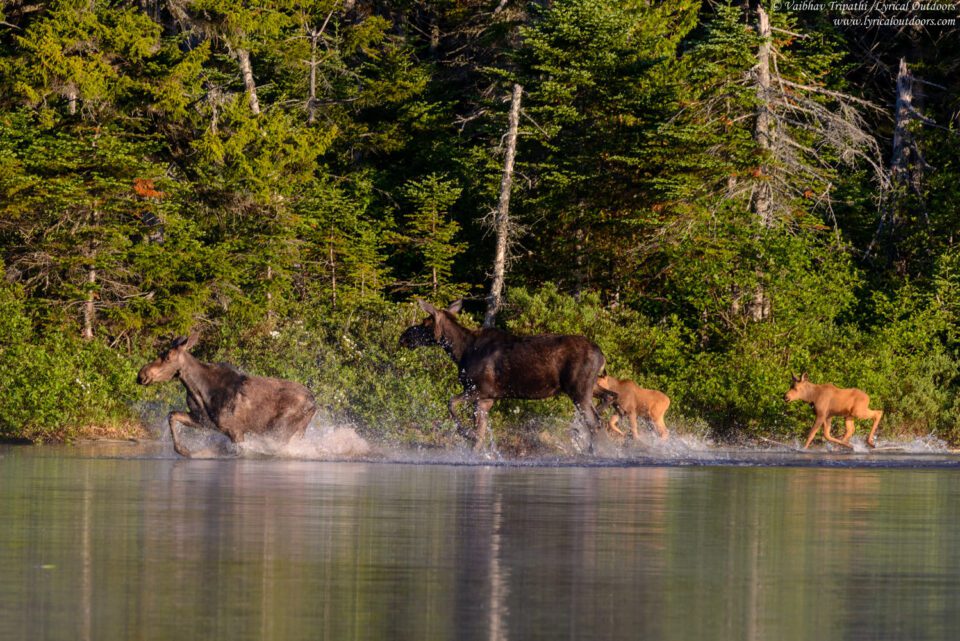In the previous two parts (I & II), I describe the careful planning involved in creating those images. Sometimes, however, with some luck, elements and light come together in several ways, (often unexpectedly), and create lasting, memorable moments. During those moments, it helps to stick to the basics, follow the light, and let your heart do the work. This third installment describes the amazing two hours I had at Sandy Stream Pond in Baxter State Park. I created 3 of my favorite images from last year in that short duration- it was like being a kid in a candy store. Please read on for the description.
Background
After the backpacking trip to Chimney Pond (see part 2), I camped for a night at the Roaring Brook Campground. Only about a quarter mile from Sandy Stream Pond, this is the best location to stay overnight if you want to visit this scenic pond at dawn during spring/summer (the park gates open at 6 am and other campground/cabins within the park are at least 30 min away by car). The evening before, I talked to a Ranger at the campground who told us about a cow Moose who is hanging out at the pond with her two recent born calves. Just to check out the area, we made the 10 minute stroll to the pond late evening. There, I imagined a composition for a morning picture, hoping that the mountains will glow at dawn. In the fading last light, we also spotted the cow Moose with her two calves. “The morning may be good”, I thought.
III. Summer Dawn, Sandy Stream Pond, Baxter State Park, ME
Composition & Setup
I setup my tripod and realized that at its normal height, the camera is not high enough to separate the edge of the mountain’s reflection from the foreground shrubs. I extended my center column (need to be mindful about the camera shake) and this 10 inches of additional height did the trick. I then pointed my camera downward to cut out the uninteresting sky and include more of the foreground plants. In addition, I also took care that the big rock in the pond intersects neither with the pond’s shoreline nor with the mountain’s reflection (barely managed it). Next, I moved around to find a composition, which emphasizes the repeated triangular patterns (see below) – this adds depth to the scene and keeps the viewer’s eye interested. The rising morning mist was an added bonus as it helps set up a distinct mood.
Technical Notes
I used a Singh-Ray 2 stop soft graduated neutral density filter to hold the exposure in the sky + mountains, while opening up the shadows and bracketed few exposures. Since, the camera was on a tripod with center column extended, I used a cable release with self-timer to avoid camera shake and handheld the grad-filter in front. A polarizer was also used to manage the reflections and glare. The 35mm slide was scanned using Nikon Coolscan 5000.
Having photographed this particular composition, I shot more frames- zoomed in, vertical, isolating the mist etc. but liked this the best. Then, I turned around and found a dramatic scene unfolding- the morning mist was beginning to rise at the eastern shore of the lake and it was being backlit by the rising sun. Summer wildflowers were growing nearby and I used those as a foreground to click a decent photograph (see below), but as the light got more intense, I realized that there is a more striking image to be made.
IV. Rising Morning Mist, Sandy Stream Pond, Baxter State Park, ME
Composition and Setup
Metering the scene with my F100, it was clear that the back lighting was too intense for Velvia 50 to handle the extreme contrast. No problem- my Nikon D610 came to rescue, which was already setup on a second tripod mounted with a 80-400 VR lens +TC (ready to photograph Moose). I swapped out cameras and now had my 24-120mm f/4 VR lens mounted on D610. Zooming in, I simplified the image and allowed the extraordinary mist be the key subject. The rocks acted as a foreground anchor and I made sure not to include too many distractions. In this image, depth is created by repeating horizontal lines- foreground rocks, middle-ground rocks, pond shoreline and the top of lit trees. These lines roughly coincide with edges in light too (another very important aspect), which creates a strong composition.
Technical Notes
I spot metered the brightest part of the mist and placed it around 1.5 stops above middle tone. Then using a cable release, I tripped the shutter and and several shots. This particular frame captured the back light at its peak intensity and the mist at its most dramatic. The image was processed in Adobe Lightroom and the digital sensor worked very well capturing the dynamic range in the scene.
After this second light show, I was feeling content. Then, I spotted the female Moose with her too calves towards the western shore line of the pond. There was more drama to unfold.
V. Chasing Away the Intruder, Sandy Stream Pond, Baxter State Park, ME
Description
It all began with the mother Moose enjoying tranquil moments with her two newborns. The calves looked relaxed and began exploring the shoreline, while the mother started to forage for food and drifted away from them. At that point, a second female Moose appeared and started to get close to the calves, which didn’t go well with our mama Moose. She warned the intruder by doing a little chase and when that didn’t help, she finally went all in and chased the intruder away. It was a quick burst of action and then calm returned to the scene. This image captures that peak action with the calves running behind their mother.
During my walk back to the campground, I ran into a BBC crew who had been in the area for past several days, filming Moose behavior for a documentary. They were staying outside the park and were just making their way to the pond (it was around 7 am). We got chatting and when I told them what happened, they got real excited. After looking at the photos, they said that perhaps, I witnessed the uncommon female Moose behavior of stealing young calves from other Moose (unsuccessful in this case). Later, an online search revealed that this behavior has been observed in Alaska as well. This was like an icing on the cake after the two amazing hours I had at Sandy Stream Pond. As a bonus, I had the place to myself with no one else around.
Technical details
The image was made using Nikon D610 and Nikkor 80-400mm AFS, VR lens with a 1.4x TC. The lens was stopped down one-stop to improve the sharpness of the combo. I use back button auto focus for wildlife shots with AF-C, d9 or d21. In this case, since the lens + TC combo has a max aperture of f/8, the camera would have used 7 points to get and track focus. It was a very bright morning with plenty of available light and the auto focus performed reasonably well. The lens was mounted on a poor man’s Wimberley head and the camera was set to normal auto-ISO. This meant that the shutter speed will be around 1/500 seconds- fast enough to freeze the action in this case. Vibration reduction (or image stabilization) was turned off. The photo was processed in Adobe Lightroom.
Here is a bonus photo of the Moose and the calves after chasing off the intruder. Hopefully you enjoyed this third instalment of the series and as always, I look forward to comments and feedback.
The post Dissecting My Favorite Photos from 2015 – Part III appeared first on Photography Life.












